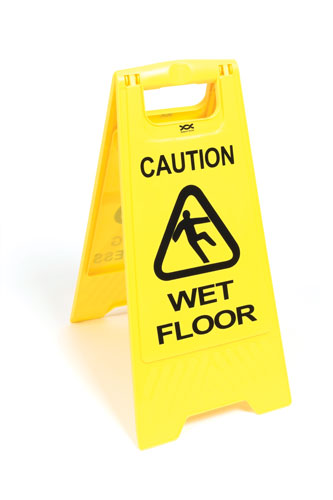Slippery When Wet

The system is pretty simple. For some reason — a customer spills a drink, a jar of tomato sauce falls off a shelf, a toddler does what toddlers are prone to doing — and the mop comes out. In the U.S., when a person or company responsible for a certain area notices that it is unsafe, that person or company is typically obligated to make it safe, or risk a lawsuit if someone other than a trespasser (and sometimes, even if a trespasser) were to get injured due the the hazard. Mopping a floor leaves it wet, creating an hazard unto itself. The solution: the ubiquitous yellow sign seen above. As the argument goes, warning people of the danger reduces if not outright removes your liability if someone were to slip and fall.
But what if someone tripped over the sign itself?
The state of Georgia can help us answer that, because at least twice, litigants have sued over that question. And one of those cases made it to the state’s Supreme Court.
On Christmas Day, 2003, a woman named Nancy Sue Brown took her daughter and grandchildren to see a movie at an AMC theater at a local mall. When their movie got out — the remake of “Cheaper By the Dozen,” in case you were wondering — the crowd made for the exits, with some (the bathroom seekers, of course) going a bit more briskly than others. A theater employee had just finished mopping the hallway and dutifully placed the “wet floor” sign in the slippery area. No one slipped due to the wet conditions, but someone did manage to knock over the sign. And by the time Ms. Brown got to the area, the sign was lying on the floor. And shortly thereafter, so was she. Her foot caught hold of the handle, in a bad way, and she fell. Unfortunately Ms. Brown had recently undergone back surgery, and the fall caused more damage than it otherwise would have. So she and her husband sued.
AMC argued, in part, that the entire point of the “wet floor” sign above was to warn of danger, and therefore, courts should encourage their use by not allowing Brown’s lawsuit to proceed. AMC cited a case stemming from a December, 1998 incident, where a “wet floor” sign, not in use, fell to the floor causing another trip-and-fall. In that case, Georgia’s Court of Appeals ruled in favor of the store, but didn’t go so far as to say that “wet floor” signs couldn’t give rise to legal liability in trip-and-fall accidents. In the Brown case, the Supreme Court therefore rejected AMC’s argument that the prior case applied.
But the Browns argued something surprising: that the “wet floor” sign was, itself, hazardous, because (they claimed) “using this type of sign in areas trafficked by hordes of customers in and of itself creates an unreasonable risk of foreseeable harm to the public in the form of tripping hazards.” That’s right — the safety sign, used in the way it was designed, was itself dangerous. The court thankfully didn’t accept that argument, at least not entirely. But it did conclude that Brown’s case could continue to a jury — “a merchant’s selection and use of devices designed to warn patrons of one hazard that have the inherent potential to expose them to a different one.”
Bonus fact: Brown’s case seems laughable until you read the details — it makes sense that a safety device, in the right (or, more accurately, wrong) situation can itself become a hazard. But what happens when the “wet floor” sign is used properly and the floor dries? Then, there’s just a sign sitting in the middle of the floor, waiting for a less-than-observant passerby to stumble over it. That’s exactly what happened at a Denny’s in Kansas City, Missouri, in 1987, except the “hazard” wasn’t a yellow sign, but an orange cone. The jury ruled for the plaintiff and Denny’s appealed. The Missouri Court of Appeals ruled that the plaintiff’s award be upheld, but the dissenting judge made an excellent point: “Simply applying the rationale of the majority opinion, the warning cones constituted no defect or dangerous condition if and while the floor was wet, but were somehow transformed into a defect or dangerous condition if the floor was dry. I am lost. The cones did not become an obstacle simply because the floor had dried.”
From the Archives: Sandwich Law: The legal wrangling over what constitutes a sandwich.
Related: Apparently, the house cleaning carts many hotels use (which have a place for a yellow “wet floor” sign to hang off of) are made by a company called Royce Rolls (zing!) and cost $1,500 a pop.
